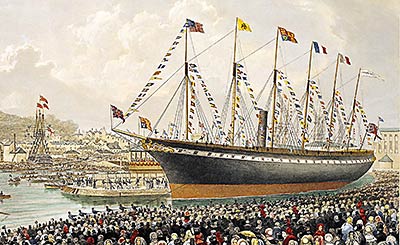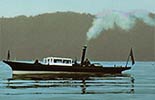STEAM POWER
One of the great inventions of the Industrial Revolution was the steam engine. The steam engine was used to move a boat through water before it was used for land locomotion. The first steamboats were paddle steamers and first British paddle steamer went into service on the River Clyde in 1812. The engine of this ship, the Comet, is in the Science Museum and a replica can be seen at Port Glasgow.
In 1836 an alternative system of propulsion was invented – the screw propeller. There was a famous ‘tug-of-war’ in 1845 between a paddle steamer called Alecto and a screw-propelled steamer, the Rattler, to test which design worked best – the Rattler won and so set the stage for the next phase of ship design. You can still take a trip on an early a screw-propelled steamer,
Dolly, built around 1850 at the Lake Windermere Steamboats and Museum.
The other breakthrough in ship design at this time was the introduction of iron hulls. These new developments were combined in Isambard Kingdom Brunel’s Great Britain, launched in 1843. She was the first seagoing vessel to be built entirely of iron and the first to be powered by a screw propeller. The SS Great Britain now sits in the Bristol dock in which she was built.
It wasn’t until the very end of the 19th century that Charles Parsons developed the marine turbine, on display at the Science Museum. It was fitted to the Turbinia, which can now be seen in the Discovery Museum Newcastle. The turbine engine rapidly took off and was used to power everything from the quickest boats in the Navy to the mighty ocean liners.


